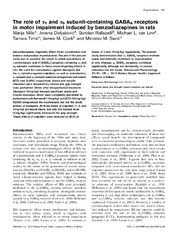The role of alpha(1) and alpha(5) subunit-containing GABA(A) receptors in motor impairment induced by benzodiazepines in rats
2012
Аутори
Milić, Marija
Divljaković, Jovana
Rallapalli, Sundari
van Linn, Michael
Timić, Tamara

Cook, James M.

Savić, Miroslav

Чланак у часопису (Објављена верзија)

Метаподаци
Приказ свих података о документуАпстракт
Benzodiazepines negatively affect motor coordination and balance and produce myorelaxation. The aim of the present study was to examine the extent to which populations of gamma-aminobutyric acid A (GABA(A)) receptors containing alpha(1) and alpha(5) subunits contribute to these motor-impairing effects in rats. We used the nonselective agonist diazepam and the alpha(1)-selective agonist zolpidem, as well as nonselective, alpha(1)-subunit and alpha(5)-subunit-selective antagonists flumazenil, beta CCt, and XLi093, respectively. Ataxia and muscle relaxation were assessed by rotarod and grip strength tests performed 20 min after intraperitoneal treatment. Diazepam (2 mg/kg) induced significant ataxia and muscle relaxation, which were completely prevented by pretreatment with flumazenil (10mg/kg) and beta CCt (20 mg/kg). XLi093 antagonized the myorelaxant, but not the ataxic actions of diazepam. All three doses of zolpidem (1, 2, and 5 mg/kg) produced ataxia, but only the highest dose (5 mg.../kg) significantly decreased the grip strength. These effects of zolpidem were reversed by beta CCt at doses of 5 and 10 mg/kg, respectively. The present study demonstrates that alpha(1) GABA(A) receptors mediate ataxia and indirectly contribute to myorelaxation in rats, whereas alpha(5) GABA(A) receptors contribute significantly, although not dominantly, to muscle relaxation but not ataxia. Behavioural Pharmacology 23:191-197
Кључне речи:
ataxia / grip strength / muscle relaxation / rat / rotarodИзвор:
Behavioural Pharmacology, 2012, 23, 2, 191-197Издавач:
- Lippincott Williams & Wilkins, Philadelphia
Финансирање / пројекти:
- Бихејвиорални ефекти понављане примене новосинтетисаних супстанци селективних за поједине подтипове бензодиазепинског места везивања ГАБА А рецептора: поређење са стандардним психофармаколошким лековима (RS-MESTD-Basic Research (BR or ON)-175076)
DOI: 10.1097/FBP.0b013e3283512c85
ISSN: 0955-8810
PubMed: 22327019
WoS: 000301285400009
Scopus: 2-s2.0-84858708930
Институција/група
PharmacyTY - JOUR AU - Milić, Marija AU - Divljaković, Jovana AU - Rallapalli, Sundari AU - van Linn, Michael AU - Timić, Tamara AU - Cook, James M. AU - Savić, Miroslav PY - 2012 UR - https://farfar.pharmacy.bg.ac.rs/handle/123456789/1698 AB - Benzodiazepines negatively affect motor coordination and balance and produce myorelaxation. The aim of the present study was to examine the extent to which populations of gamma-aminobutyric acid A (GABA(A)) receptors containing alpha(1) and alpha(5) subunits contribute to these motor-impairing effects in rats. We used the nonselective agonist diazepam and the alpha(1)-selective agonist zolpidem, as well as nonselective, alpha(1)-subunit and alpha(5)-subunit-selective antagonists flumazenil, beta CCt, and XLi093, respectively. Ataxia and muscle relaxation were assessed by rotarod and grip strength tests performed 20 min after intraperitoneal treatment. Diazepam (2 mg/kg) induced significant ataxia and muscle relaxation, which were completely prevented by pretreatment with flumazenil (10mg/kg) and beta CCt (20 mg/kg). XLi093 antagonized the myorelaxant, but not the ataxic actions of diazepam. All three doses of zolpidem (1, 2, and 5 mg/kg) produced ataxia, but only the highest dose (5 mg/kg) significantly decreased the grip strength. These effects of zolpidem were reversed by beta CCt at doses of 5 and 10 mg/kg, respectively. The present study demonstrates that alpha(1) GABA(A) receptors mediate ataxia and indirectly contribute to myorelaxation in rats, whereas alpha(5) GABA(A) receptors contribute significantly, although not dominantly, to muscle relaxation but not ataxia. Behavioural Pharmacology 23:191-197 PB - Lippincott Williams & Wilkins, Philadelphia T2 - Behavioural Pharmacology T1 - The role of alpha(1) and alpha(5) subunit-containing GABA(A) receptors in motor impairment induced by benzodiazepines in rats VL - 23 IS - 2 SP - 191 EP - 197 DO - 10.1097/FBP.0b013e3283512c85 ER -
@article{
author = "Milić, Marija and Divljaković, Jovana and Rallapalli, Sundari and van Linn, Michael and Timić, Tamara and Cook, James M. and Savić, Miroslav",
year = "2012",
abstract = "Benzodiazepines negatively affect motor coordination and balance and produce myorelaxation. The aim of the present study was to examine the extent to which populations of gamma-aminobutyric acid A (GABA(A)) receptors containing alpha(1) and alpha(5) subunits contribute to these motor-impairing effects in rats. We used the nonselective agonist diazepam and the alpha(1)-selective agonist zolpidem, as well as nonselective, alpha(1)-subunit and alpha(5)-subunit-selective antagonists flumazenil, beta CCt, and XLi093, respectively. Ataxia and muscle relaxation were assessed by rotarod and grip strength tests performed 20 min after intraperitoneal treatment. Diazepam (2 mg/kg) induced significant ataxia and muscle relaxation, which were completely prevented by pretreatment with flumazenil (10mg/kg) and beta CCt (20 mg/kg). XLi093 antagonized the myorelaxant, but not the ataxic actions of diazepam. All three doses of zolpidem (1, 2, and 5 mg/kg) produced ataxia, but only the highest dose (5 mg/kg) significantly decreased the grip strength. These effects of zolpidem were reversed by beta CCt at doses of 5 and 10 mg/kg, respectively. The present study demonstrates that alpha(1) GABA(A) receptors mediate ataxia and indirectly contribute to myorelaxation in rats, whereas alpha(5) GABA(A) receptors contribute significantly, although not dominantly, to muscle relaxation but not ataxia. Behavioural Pharmacology 23:191-197",
publisher = "Lippincott Williams & Wilkins, Philadelphia",
journal = "Behavioural Pharmacology",
title = "The role of alpha(1) and alpha(5) subunit-containing GABA(A) receptors in motor impairment induced by benzodiazepines in rats",
volume = "23",
number = "2",
pages = "191-197",
doi = "10.1097/FBP.0b013e3283512c85"
}
Milić, M., Divljaković, J., Rallapalli, S., van Linn, M., Timić, T., Cook, J. M.,& Savić, M.. (2012). The role of alpha(1) and alpha(5) subunit-containing GABA(A) receptors in motor impairment induced by benzodiazepines in rats. in Behavioural Pharmacology Lippincott Williams & Wilkins, Philadelphia., 23(2), 191-197. https://doi.org/10.1097/FBP.0b013e3283512c85
Milić M, Divljaković J, Rallapalli S, van Linn M, Timić T, Cook JM, Savić M. The role of alpha(1) and alpha(5) subunit-containing GABA(A) receptors in motor impairment induced by benzodiazepines in rats. in Behavioural Pharmacology. 2012;23(2):191-197. doi:10.1097/FBP.0b013e3283512c85 .
Milić, Marija, Divljaković, Jovana, Rallapalli, Sundari, van Linn, Michael, Timić, Tamara, Cook, James M., Savić, Miroslav, "The role of alpha(1) and alpha(5) subunit-containing GABA(A) receptors in motor impairment induced by benzodiazepines in rats" in Behavioural Pharmacology, 23, no. 2 (2012):191-197, https://doi.org/10.1097/FBP.0b013e3283512c85 . .

